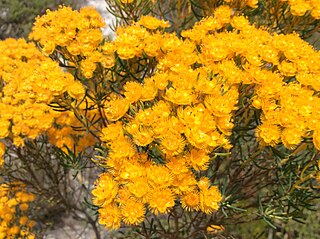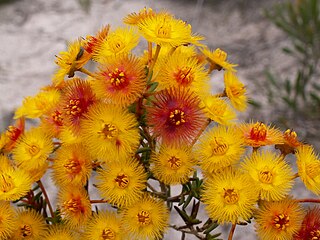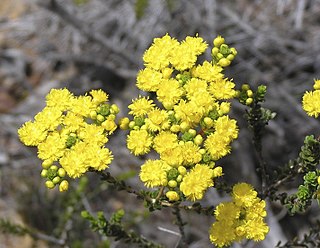
Verticordia nitens, commonly known as Christmas Morrison and other names, is a flowering plant in the myrtle family, Myrtaceae and is endemic to the south-west of Western Australia. The Noongar peoples know the plant as kotyeningara. It is an upright shrub with glistening and perfumed flower heads that appear between October and February. The small compact and erect flowers have been noted for their beauty. Although it occurs in areas near Perth, Morrison featherflower is not classed as rare or endangered because it still occurs in large populations, although its numbers have undoubtedly been reduced as a result of urban development.

Verticordia acerosa is a flowering plant in the myrtle family, Myrtaceae and is endemic to the south-west of Western Australia. It is a shrub with yellow flowers which change colour through red to almost black as they age. There are two varieties which vary in their leaf shape, their flower colour and some of the structures in the flower.
Verticordia patens is a flowering plant in the myrtle family, Myrtaceae and is endemic to the south-west of Western Australia. It is a shrub with linear, pointed leaves and faintly scented, pale yellow flowers in open heads on the ends of the branches. It is fairly common in a small area south of Badgingarra.
Verticordia subg. Eperephes is a botanical name for a grouping of similar plant species in the genus Verticordia. This subgenus contains six sections, classifying forty four species, of Alex George's infrageneric arrangement. The subgeneric name is derived from the Greek word eperephes, in reference to over-hanging parts at the hypanthium which differentiate the contained species from the other two subgenera.
Verticordia subg. Verticordia is a botanical name for a grouping of similar plant species in the genus Verticordia. This subgenus contains eleven sections, classifying thirty six species, of Alex George's infrageneric arrangement. A number of anatomical features differentiate the contained species from the other two subgenera.
Verticordia sect. Verticordia is one of eleven sections in the subgenus Verticordia. It includes eight species of plants in the genus Verticordia. Plants in this section are open to bushy shrubs up to 1 m (3 ft) tall with needle-like leaves, feather-like sepals and anthers opening by slanting pores. When Johannes Conrad Schauer described other subgenera in Verticordia, subgenus Verticordia became an autonym after Augustin de Candolle who described the genus in 1828. When Alex George reviewed the genus in 1991, he took the name of this section from that of the subgenus.
Verticordia sect. Chrysoma is one of seven sections in the subgenus Chrysoma. It includes four species of plants in the genus Verticordia. Plants in this section are small shrubs with small, bright yellow flowers which usually turn red as they age. They have sepals with fringed lobes and petals which have lobes arranged like the fingers of a hand. The subgenus Chrysoma was originally described in 1843 by Johannes Conrad Schauer and the description was published in Monographia Myrtacearum Xerocarpicarum. When Alex George reviewed the genus in 1991, he took the name of this section from that of the subgenus.

Verticordia is a genus of more than 100 species of plants commonly known as featherflowers, in the myrtle family, Myrtaceae. They range in form from very small shrubs such as V. verticordina to trees like V. cunninghamii, some spindly, others dense and bushy, but the majority are woody shrubs up to 2.0 m (7 ft) tall. The flowers are variously described as "feathery", "woolly" or "hairy" and are found in most colours except blue. They often appear to be in rounded groups or spikes but in fact are always single, each flower borne on a separate stalk in a leaf axil. Each flower has five sepals and five petals all of a similar size with the sepals often having feathery or hairy lobes. There are usually ten stamens alternating with variously shaped staminodes. The style is simple, usually not extending beyond the petals and often has hairs near the tip. All but two species are found in Southwest Australia, the other two occurring in the Northern Territory.
Verticordia sect. Tropica is one of six sections in the subgenus Eperephes. It includes three species of plants in the genus Verticordia. Plants in this section occur are the only verticordias to occur in tropical areas of Western Australia and the Northern Territory, including the Kimberley and Kakadu National Park and they have the ability to regrow from a lignotuber after fire. They have leaves which vary in size from tiny and pressed against the stem to long and curved but are always linear in shape. The flowers have fringed petals and lobed sepals with small, ear-like appendages and the style has a narrow band of hairs near its tip.

Verticordia sect. Chrysorhoe is a section that describes three shrub species in the genus Verticordia. The section is one of seven in the subgenus, Verticordia subg. Chrysoma. The three species in this section are inflexible, upright shrubs usually no taller than 2 m (7 ft). They have needle-like leaves and their flowers are arranged corymb-like, sometimes densely on the ends of the branches. The flowers are orange, gold-coloured or yellow and the petals have toothed margins, the anthers have a flattened, swollen appendage and the staminodes are narrow.
Verticordia sect. Cooloomia is a section that describes a single species in the flowering plant genus Verticordia. The section is one of seven in the subgenus, Verticordia subg. Chrysoma. The characteristics of this section includes leaves that differ in shape, depending on their position on the plant and very small sepals. In most other respects, the one plant in this section is similar to those in section Verticordia sect. Chrysoma.
Verticordia sect. Synandra is a section that describes a single species in the genus Verticordia. The section is one of seven in the subgenus, Verticordia subg. Chrysoma. The characteristics of this section includes having branches and flower stalks which are covered with stiff, bristly hairs, and stamens and staminodes which are joined at their base in a tube. The subspecies and varieties of the single species in this section all have bright green leaves and superficially resemble dwarf pine trees.

Verticordia endlicheriana is a flowering plant in the myrtle family, Myrtaceae and is endemic to the south-west of Western Australia. It is a shrub with narrow leaves and yellow flowers which in some varieties age to red. It is a variable species and in his 1991 paper, Alex George formally described five varieties.

Verticordia grandiflora, commonly known as claw featherflower, clawed featherflower or horned featherflower, is a flowering plant in the myrtle family Myrtaceae, and is endemic to the south-west of Western Australia. It is a small, rigid shrub with many short side-branches, mostly linear leaves and heads of yellow flowers which soon age to reddish but which are among the largest in the genus. It is similar in appearance to several other species of verticordias with which it is often confused.

Verticordia nobilis, commonly known as northern grandiflora, is a flowering plant in the myrtle family, Myrtaceae and is endemic to the south-west of Western Australia. It is an openly branched shrub with linear leaves and groups of scented, yellow flowers which turn deep red as they age.

Verticordia serrata is a flowering plant in the myrtle family, Myrtaceae and is endemic to the south-west of Western Australia. It is a spindly or openly branched shrub with hairy, egg-shaped leaves and flowers which are golden at first, then fade to a greyish colour.
Verticordia sect. Jugata is one of seven sections in the subgenus Chrysoma. It includes seven species of plants in the genus Verticordia. Plants in this section are mostly bushy shrubs to 1.0 m (3 ft) tall with bright yellow flowers which in some species turn red as they age. They have sepals with fringed lobes, petals which have lobes arranged like the fingers of a hand and bracteoles which are joined together and remain attached to the flower after it opens. When Alex George reviewed the genus in 1991, he described the section and gave it the name Jugata. The name Jugata is from the Latin word jugis meaning "yoked together" referring to the arrangement of the bracteoles in these species.
Verticordia sect. Unguiculata is one of seven sections in the subgenus Chrysoma. It includes three species of plants in the genus Verticordia. Plants in this section are rigid shrubs with a single main stem and are less than 1.0 m (3 ft) tall. They have yellow flowers arranged in corymb-like groups and the flowers turn red as they age. They have sepals with fringed lobes, petals which have lobes arranged like the fingers of a hand and anthers which have an appendage which looks like a pair of claws. When Alex George reviewed the genus in 1991, he described the section and gave it the name Unguiculata. The name Unguiculata is the diminutive form of the Latin word unguis meaning "little claw" or "little talon" referring to the anther appendage in these species.
Verticordia sect. Sigalantha is one of seven sections in the subgenus Chrysoma. It includes two species of plants in the genus Verticordia. Plants in this section are rigid shrubs with a single main stem and are up to 1.0 m (3 ft) tall. They have golden-yellow flowers with prominent shining petals. The flowers are arranged in corymb-like groups and become pale or grey as they age. The bracteoles fall off the flower as it opens. When Alex George reviewed the genus in 1991, he described the section and gave it the name Sigalantha. The name Sigalantha is derived from the Ancient Greek words sigaloeis meaning "shiny" and anthos meaning "flower" referring to the shiny petals of these species.
Verticordia sect. Catocalypta is one of eleven sections in the subgenus Verticordia. It includes seven species of plants in the genus Verticordia. Plants in this section are small, bushy shrubs which grow to a height of up to 1 m (3 ft), have thick, fleshy, leaves which are triangular in cross-section. The flowers are arranged in open, corymb-like heads of relatively large flowers. Importantly, their sepals have down-turned, tufts of hair which surround the floral cup.







